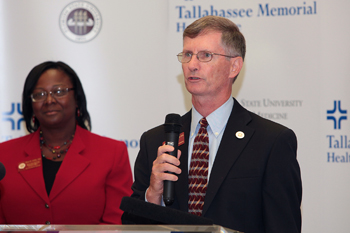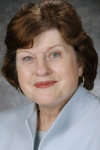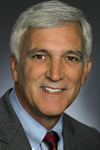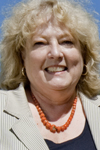
|
OTHER TOP STORIES |
|
For more about faculty research and other items, see Faculty News.
TMH, MEDICAL SCHOOL JOINTLY ESTABLISHING RESIDENCY PROGRAM The Tallahassee Memorial HealthCare Board of Directors and the Florida State University College of Medicine have announced plans to pursue a joint internal medicine residency program for the Big Bend. The Tallahassee Memorial and Florida State University Internal Medicine Residency Program would be housed at Tallahassee Memorial's main campus, and the College of Medicine would be the institutional sponsor. The program could begin accepting applications for resident physicians as early as fall 2011.
Florida ranks No. 44 in the number of graduate medical education slots for residency programs. Recent legislation will soon allow many vacant residency slots to be transferred to new regions and hospitals. Florida is expected to receive approximately 300 slots. The bill also gives preference to teaching hospitals that focus on primary care and general surgery residencies, emphasize community-based training, and are located in areas with growing populations, criteria that TMH satisfies on all counts.
“Tallahassee Memorial Hospital has the opportunity to expand medical training and care on our campus for the benefit of our region’s citizens and graduating medical students. The program will also complement Tallahassee Memorial’s already strong Family Medicine Residency Program, which has served our community so well,” said Mark O’Bryant, president and CEO of Tallahassee Memorial HealthCare.
Since 1973, 301 physicians have completed their training through the Family Medicine Residency Program, with more than half selecting to practice in Florida. As studies show that roughly 60 percent of doctors practice where they complete their residency, a second program at Tallahassee Memorial would bring many new physicians to our region, aiding the state in facing its longstanding challenge to retain doctors.
“It is wonderful to partner with TMH in this endeavor and build on the record of success they have had with the Family Medicine Residency Program,” said Dean John P. Fogarty (pictured above with Senior Associate Dean Alma Littles). “Internal medicine is the next logical step to increase the primary care workforce here in Tallahassee.”
DANCE MARATHON PRESENTS $211,000 CHECK Dance Marathon at Florida State University and Children’s Miracle Network at Shands Children’s Hospital at the University of Florida have presented a $211,000 check to the College of Medicine for the benefit of children throughout Gadsden and Leon counties.
The proceeds are part of the record $451,000 raised in 2010 by Dance Marathon, the largest student-run philanthropy on the Florida State campus. Children’s Miracle Network at Shands Children’s Hospital at UF distributes part of the money raised to the Florida State College of Medicine for use in pediatric outreach programs.
The College of Medicine is using part of the proceeds to pay for a school-based health program in Gadsden designed to address health-care disparities among area children. The record proceeds this year will help make mental-health care more available in the schools. Other projects funded by the Dance Marathon earnings include equipment for the pediatrics unit at Tallahassee Memorial Hospital.
NEWS FROM THE TRANSLATIONAL SCIENCE LAB Roger Mercer, Ph.D., director of the Translational Science Laboratory, and Jessica DeLeon, Ph.D., clinical research projects director, will be crucial to the launch of the College of Medicine’s Translational Science Initiative. Mercer is an analytical chemist with more than 20 years of experience. He spent the past nine years leading the proteomics core lab at a San Francisco Bay Area company, Exelixis. DeLeon earned her Ph.D. in anthropology from the University of Florida and has been engaged in public health service initiatives both at the UF College of Pharmacy and, since 2007, at Nova Southeastern College of Osteopathic Medicine, specifically with an HRSA-funded Geriatric Education Center.
CLERKSHIP FACULTY MEMBERS HONORED Clerkship faculty members Jason L. Salagubang, M.D., in Orlando, and Joanne DeAusen Saxour, M.D., in Daytona Beach, have received the 2010 Pfizer Teacher Development Award given by the AAFP Foundation. They were among only 13 community-based family physicians and part-time teachers nationwide who were selected. Recipients are selected based on their scholastic achievement, leadership qualities and dedication to family medicine. “Both individuals are very deserving of this award, and it speaks to the teaching excellence that is consistently displayed by the clerkship faculty in our distributed campus system,” said Dennis Baker, Ph.D., associate dean for faculty development. Richard G. Roberts, foundation president, said these awards “spotlight the best of our profession: those in active practice who give of themselves to teach, mentor, and inspire residents and students. Tomorrow’s family doctors and their patients will be better because of their efforts.”
EDWARDS INCLUDED AMONG AM CLASSICS Janine Edwards, Ph.D., chair of the Department of Medical Humanities and Social Sciences, is featured in AM Classics — a collection of articles published in Academic Medicine since 1990 that have been cited 50 or more times (according to the ISI Web of Science database). “This is an impressive achievement,” Editor-in-Chief Steven L. Kanter wrote to the College of Medicine, “and I want to alert you to this important contribution from your institution.” Edwards’ article is titled “The Interview in the Admission Process” (March 1990).
GONZALEZ-ROTHI TO BECOME CHAIR OF CLINICAL SCIENCES
The College of Medicine has hired Ricardo J. Gonzalez-Rothi, M.D., as
professor and chair
“I am particularly interested in FSU’s emphasis on innovative ways of preparing a new generation of physicians trained with the needs of the public in mind,” Gonzalez-Rothi said. “We need scientifically well-trained doctors who are prepared to function with safety and confidence in a health system which has become increasingly technically complex.”
Gonzalez-Rothi brings a wealth of teaching, practice, research and leadership experience to the Florida State College of Medicine, where he replaces interim chair Harold Bland, M.D. Bland will continue in his role as professor and pediatrics education director.
For 25 years Gonzalez-Rothi, who was born in Cuba and is a graduate of Cornell University and the New York University School of Medicine, has volunteered as a physician in an evening rural health clinic. He is a charter member of the UF College of Medicine’s Society of Teaching Scholars, recognizing faculty members who have excelled in teaching excellence and educational scholarship. In 2009, he received the UF Department of Medicine Excellence in Teaching Award for Medical Students, Residents and Fellows. Gonzalez-Rothi is a fellow of the American College of Chest Physicians.
“His background and interests are a great mission fit for the college as we prepare the next generation of physicians for practice in rural and underserved communities in Florida,” Dean John Fogarty said.
Following completion of his medical degree at NYU, Gonzalez-Rothi completed residency training in internal medicine and a fellowship in pulmonary medicine, both at the University of Florida Shands Teaching Hospital.
CREDO AWARD GOES TO NOWAKOWSKI
This year, for the first time, the University of Medicine and Dentistry of
New Jersey
University President William F. Owen Jr., M.D., presented the awards. “The
Credo describes how the university views itself and what aspirations we have
for ourselves,” he said. “There is no question, from the way these people
are perceived and the contributions they have made, that we have a really
terrific organization.”
NEW PROGRAM ASSISTS FSU POSTDOCS WITH CAREER SEARCH
Tim Megraw, Ph.D., has been appointed director of the new
Postdoctoral Career
KABBAJ GRANT FOCUSES ON ANXIETY AMONG FEMALES Anxiety disorders afflict women twice as often as men, but estrogen might not be the reason. Testosterone, though, could be. That is one of the preliminary findings in the lab of Florida State University researcher Mohamed Kabbaj, Ph.D., associate professor in the College of Medicine. He recently was awarded a five-year, $1.8 million grant from the National Institute of Mental Health to investigate the sex differences in anxiety. His research team also is working to identify the role of a gene called zif268.
“So far, zif268 plays a major role in learning, memory and drug addiction,” Kabbaj said. “I think our work shows for the first time that it's also implicated in anxiety.”
In their lab, Kabbaj and his team exposed male and female rats to situations that provoked anxiety. They knew stress would activate the zif268 gene, so they explored the brains of the rats to see how the gene had expressed itself. Kabbaj called it “a fishing expedition.” The results surprised them. Only one part of the brain showed a difference in gene expression between males and females: the medial prefrontal cortex, the part of the brain that allows humans to experience emotions and the meaning of things.
Males have more zif268 in their prefrontal cortex than females do. Males also are less anxious. So the researchers reduced the expression of zif268 in the prefrontal cortex of the males. Result: The males became as anxious as the females.
“One of the questions you have to ask,” Kabbaj said, “is why males have more zif than females. We think it's because of testosterone. Testosterone is keeping that level of zif very high. Our recent findings show that the hormone estrogen is not implicated in sex differences in anxiety. However, our preliminary data show the male hormone testosterone may be protecting male rats from developing anxiety. The fact that females do not have a lot of testosterone may put them at risk of developing anxiety disorders.”
MAITLAND CO-AUTHOR OF PARKINSON’S STUDY Charles G. “Gerry” Maitland, M.D., professor of neurology, was one of the co-authors of a study about the challenges that walking poses for older adults, including those with Parkinson’s disease. The Florida State University study found that older adults with Parkinson’s disease altered their gait when asked to perform increasingly difficult verbal tasks while walking. But the real surprise was that even older adults without a neurological impairment demonstrated similar difficulties walking and talking.
A disruption in gait could place Parkinson’s patients and the elderly at an increased risk of falls, according to the Florida State researchers.
Francis Eppes Professor of Communication Science and Disorders Leonard L. LaPointe and co-authors Julie A.G. Stierwalt, associate professor in the School of Communication Science and Disorders, and Maitland outlined their findings in “Talking while walking: Cognitive loading and injurious falls in Parkinson’s disease.” The study was published in the October issue of the International Journal of Speech-Language Pathology.
Twenty-five individuals with Parkinson’s disease — six women and 19 men — participated in the study. The mean age of participants was 67.4 years. Thirteen people who matched in age and education but without a reported history of neurological impairment made up the control group. The researchers used the GAITRite Portable Walkway System, a 14-foot mat containing 13,824 sensors that measures, interprets and records gait data as participants walk on it. After establishing a baseline, the participants were asked to walk while completing a “low-load” task (counting by ones); a “mid-load” task (serial subtraction of threes); and a “high-load” task (continuation of an alphanumeric sequence, such as D-7, E-8, F-9, etc.).
While there were no significant differences between the two groups in stride length and step velocity, members of the control group significantly increased the time they spent stabilizing on two feet from the low-load to high-load tasks. The researchers theorized that the control group used the “double support time” as a compensatory strategy to gain greater control of gait and balance. The Parkinson’s group did not use this strategy and therefore placed themselves at greater risk for falls, they said.
‘A VISION OF A MODEL FOR THE FUTURE?’
Myra Hurt, Ph.D., senior associate dean for research and graduate
programs, was one of
The ideas about admission and diversity will sound familiar to anyone who knows the Florida State College of Medicine. The paper is a product of Hurt’s small discussion group (summer 2009) at the Harvard Macy Institute’s Leading Innovations in Health Care and Education. “I have been a faculty member for the summer Macy program for a number of years,” she said, “basically since I went in June 1999, with an idea for a new medical school with a radical training model as my project.” That idea became the College of Medicine.
Excerpt from the authors’ summary: “In brief, the hypothetical [Kaiser Permanente School of Medicine] could be envisaged as a model of a lifetime medical school that would initially draw candidates from a diverse socioeconomic pool of applicants and guide them through a series of carefully monitored, modular, self-paced basic science and clinical skills learning programs, up to a phase where they would branch out into specialty programs leading to graduation as physician, physician’s assistant, nurse, nurse practitioner, or health care administrator. Tuition would be less costly because students would also be employees of the organization and would likely remain in the organization throughout their extensive training careers, from medical school and into subspecialty certification — and possibly as full-fledged physician employees. This system would be satisfying to patients as well as students because it would provide more effective longitudinal and preventive care. The model is offered as an alternate stream of medical education that would not supplant university medical schools but would operate alongside them.”
LITTLES JOINS PHYSICIAN WORKFORCE ADVISORY COUNCIL Alma Littles, M.D., senior associate dean for medical education and academic affairs, has been appointed to a four-year term on the state Physician Workforce Advisory Council. The council’s primary responsibility is to advise the state surgeon general on matters concerning current and projected physician workforce needs in this state. Duties include: a. Reviewing the physician workforce survey materials and making recommendations to the Florida Department of Health regarding the changes to the survey completed by physicians licensed under Chapter 458 or 459 of the Florida Statutes. b. Reviewing graduate medical education data as it relates to the number, location, cost and reimbursement of residency programs and positions. c. Assisting the department in preparing the Physician Workforce Annual Report. d. Assisting in the preparation of a Physician Workforce Strategic Plan and the implementation of any recommendations related to strategic planning. e. Monitoring and providing recommendations regarding the need for an increased number of primary care or other physician specialties to provide the necessary current and projected health and medical services for the state. f. Monitoring and making recommendations regarding the status of the needs relating to graduate medical education in the state.
BIOMEDICAL SYMPOSIUM SET FOR JANUARY
GRANT FOR PRENATAL PROGRAM AT SACRED HEART SETON CENTER
The College of Medicine’s Obstetrics and Gynecology Residency Program at
Sacred Heart Women’s Hospital was recently awarded a $3,000 Community Awards
Program grant from the Florida Chapter of the March of Dimes. The goal of
the program is to identify and fund community-based programs addressing the
health concerns of pregnant women in Florida.
|
 |
 |
 |
| E-mail Alumni Affairs Phone: 850-645-9428 | ||
|
|
|
Florida State University
|
College of Medicine
|
Copyright 2013
|



 of
the Department of Clinical Sciences. Gonzalez-Rothi, whose leadership of the
department will officially begin Jan. 1, currently is a professor of
medicine and pharmaceutics at the University of Florida College of Medicine
and is Chief of Medical Service at the North Florida/South Georgia Veterans
Health System.
of
the Department of Clinical Sciences. Gonzalez-Rothi, whose leadership of the
department will officially begin Jan. 1, currently is a professor of
medicine and pharmaceutics at the University of Florida College of Medicine
and is Chief of Medical Service at the North Florida/South Georgia Veterans
Health System. bestowed
Credo in Action Awards on individuals who epitomize the words and spirit of
UMDNJ’s
bestowed
Credo in Action Awards on individuals who epitomize the words and spirit of
UMDNJ’s
 the
authors of a paper in the Fall 2010 edition of The Permanente Journal:
“
the
authors of a paper in the Fall 2010 edition of The Permanente Journal:
“ The Department of Biomedical Sciences will host a symposium in early January
to showcase the diversity and congruity of biomedical research at Florida
State University. It’s titled “From Molecules to Medicine.” This effort is
led by Michael Blaber, Ph.D., with a steering committee composed of
Tim Megraw in the College of Medicine, along with Hedi Mattoussi
(Chemistry and Biochemistry), Richard Hyson (Psychology/Neuroscience
Program), Scott Stagg (Molecular Biophysics) and Hengli Tang (Biology).
The Department of Biomedical Sciences will host a symposium in early January
to showcase the diversity and congruity of biomedical research at Florida
State University. It’s titled “From Molecules to Medicine.” This effort is
led by Michael Blaber, Ph.D., with a steering committee composed of
Tim Megraw in the College of Medicine, along with Hedi Mattoussi
(Chemistry and Biochemistry), Richard Hyson (Psychology/Neuroscience
Program), Scott Stagg (Molecular Biophysics) and Hengli Tang (Biology).